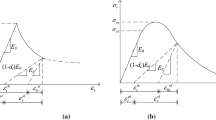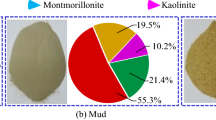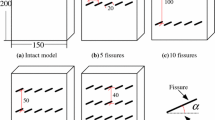Abstract
Filling materials such as clay or sand widely exist in natural rock joints and work as weak bonds between the joint surfaces. The fillings affect rock deformation and failure behavior, and show different influences in terms of single crack or multiple cracks. While most of the literature have focused on unfilled cracks in brittle materials, this study aims to investigate various filling materials on the crack behavior, e.g., initiation, secondary cracks and peak strength. In this paper, the crack propagation in rock-like specimens with double-filled and unfilled cracks are investigated experimentally and numerically. Uniaxial compression tests were conducted and the experimental observations indicate that the peak stress and first crack initiation stress of the specimens vary with different geometries and different filling materials, while the crack initiation location and the pattern of crack coalescence show similar behavior between filled and unfilled cracks. In parallel to the experimental tests, numerical simulations were carried out using a modified phase field model (PFM) to complement the experiments and provide a new perspective. The PFM is found to produce consistent stress–strain curve, strength, and crack patterns with those observed in the experimental tests for both unfilled and filled cracks.




















Similar content being viewed by others
Abbreviations
- \(\alpha \) :
-
Inclination angle of original crack
- \({\varvec{b}}\) :
-
Body force
- E :
-
Young’s modulus
- \({\varvec{\varepsilon }}_+\) :
-
Tensile strain
- \(G_\mathrm{c}\) :
-
Critical energy release rate
- \(G_\mathrm{cII}\) :
-
Critical energy release rate of mode II
- \(H_\mathrm{u}\) :
-
Driving force of phase field
- \(\lambda \) :
-
First Lamé constant
- L1:
-
Original crack length
- \(\mu \) :
-
Shear modulus
- \(\phi \) :
-
Phase field
- \(\psi _\mathrm{ts}\) :
-
Energy contribution of tensile strains to mode II crack
- \(\varphi \) :
-
Internal friction angle
- \({\varvec{u}}\) :
-
Displacement field
- \(\beta \) :
-
Rock bridge angle
- c :
-
Cohesion
- \({\varvec{\varepsilon }}\) :
-
Strain tensor
- \({\varvec{\varepsilon }}_-\) :
-
Compressive strain
- \(G_\mathrm{cI}\) :
-
Critical energy release rate of mode I
- h :
-
Maximum element size
- k :
-
Stability parameter
- \(l_0\) :
-
Length scale parameter
- L2:
-
Rock bridge length
- \(\nu \) :
-
Poisson’s ratio
- \(\psi _\mathrm{t}\) :
-
Energy contribution due to positive volumetric strain
- \(\psi _\mathrm{cs}\) :
-
Energy contribution of compressive strains to mode II crack
- \({\varvec{\sigma }}\) :
-
Stress tensor
- \({\varvec{x}}\) :
-
Position vector
References
Ambati M, Gerasimov T, De Lorenzis L (2015) A review on phase-field models of brittle fracture and a new fast hybrid formulation. Comput Mech 55(2):383–405
Amor H, Marigo J-J, Maurini C (2009) Regularized formulation of the variational brittle fracture with unilateral contact: Numerical experiments. J Mech Phys Solids 57(8):1209–1229
Belytschko T, Black T (1999) Elastic crack growth in finite elements with minimal remeshing. Int J Numer Methods Eng 45(5):601–620
Bilgen C, Weinberg K (2019) On the crack-driving force of phase-field models in linearized and finite elasticity. Comput Methods Appl Mech Eng 353:348–372
Bobet A, Einstein H (1998a) Fracture coalescence in rock-type materials under uniaxial and biaxial compression. Int J Rock Mech Min Sci 35(7):863–888
Bobet A, Einstein HH (1998b) Numerical modeling of fracture coalescence in a model rock material. Int J Fract 92(3):221
Borden MJ, Verhoosel CV, Scott MA, Hughes TJ, Landis CM (2012) A phase-field description of dynamic brittle fracture. Comput Methods Appl Mech Eng 217:77–95
Bouchard P-O, Bay F, Chastel Y, Tovena I (2000) Crack propagation modelling using an advanced remeshing technique. Comput Methods Appl Mech Eng 189(3):723–742
Bourdin B, Francfort GA, Marigo J-J (2000) Numerical experiments in revisited brittle fracture. J Mech Phys Solids 48(4):797–826
Bourdin B, Francfort GA, Marigo J-J (2008) The variational approach to fracture. J Elast 91(1–3):5–148
Brace W, Bombolakis E (1963) A note on brittle crack growth in compression. J Geophys Res 68(12):3709–3713
Bryant EC, Sun W (2018) A mixed-mode phase field fracture model in anisotropic rocks with consistent kinematics. Comput Methods Appl Mech Eng 342:561–584
Cheng Z, Wang Z, Luo Z (2019) Dynamic fracture analysis for shale material by peridynamic modelling. Comput Model Eng Sci 118(3):509–527
Clayton JD (2019) Computational modeling of dual-phase ceramics with finsler-geometric phase field mechanics. Comput Model Eng Sci 120(2):333–350
Cook NG (1965) The failure of rock. Int J Rock Mech Min Sci Geomech Abstr 2:389–403
Deb D, Das KC (2009) Extended finite element method (xfem) for analysis of cohesive rock joint. J Sci Indus Res 68:575–583
Donze F, Bouchez J, Magnier S (1997) Modeling fractures in rock blasting. Int J Rock Mech Min Sci 34(8):1153–1163
Fakhimi A, Gharahbagh EA (2011) Discrete element analysis of the effect of pore size and pore distribution on the mechanical behavior of rock. Int J Rock Mech Min Sci 48(1):77–85
Feng D-C, Wu J-Y (2018) Phase-field regularized cohesive zone model (czm) and size effect of concrete. Eng Fract Mech 197:66–79
Fowell R, Hudson J, Xu C, Zhao X et al (1995) Suggested method for determining mode i fracture toughness using cracked chevron notched brazilian disc (ccnbd) specimens. Int J Rock Mech Min Sci Geomech Abstr 7:322A
Hoek E, Bieniawski Z (1965) Brittle fracture propagation in rock under compression. Int J Fract Mech 1(3):137–155
Hosseini-Tehrani P, Hosseini-Godarzi A, Tavangar M (2005) Boundary element analysis of stress intensity factor ki in some two-dimensional dynamic thermoelastic problems. Eng Anal Bound Elem 29(3):232–240
Lajtai E (1974) Brittle fracture in compression. Int J Fract 10(4):525–536
Li H, Wong LNY (2012) Influence of flaw inclination angle and loading condition on crack initiation and propagation. Int J Solids Struct 49(18):2482–2499
Li Q, Li Z, Xu X (2020) Experimental study for the effect of fillings on properties of brittle rock containing two parallel flaws. Geotech Geol Eng 38:3643–3651
Liu Z, Menouillard T, Belytschko T (2011) An xfem/spectral element method for dynamic crack propagation. Int J Fract 169(2):183–198
Lu X, Wu W-L (2006) A subregion drbem formulation for the dynamic analysis of two-dimensional cracks. Math Comput Modell 43(1–2):76–88
Meng F, Zhou H, Wang Z, Zhang L, Kong L, Li S, Zhang C (2017) Influences of shear history and infilling on the mechanical characteristics and acoustic emissions of joints. Rock Mech Rock Eng 50(8):2039–2057
Miehe C, Hofacker M, Welschinger F (2010) A phase field model for rate-independent crack propagation: Robust algorithmic implementation based on operator splits. Comput Methods Appl Mech Eng 199(45–48):2765–2778
Moës N, Dolbow J, Belytschko T (1999) A finite element method for crack growth without remeshing. Int J Numer Methods Eng 46(1):131–150
Mughieda O, Alzo’ubi AK (2004) Fracture mechanisms of offset rock joints-a laboratory investigation. Geotech Geol Eng 22(4):545–562
Nikravesh S, Gerstle W (2018) Improved state-based peridynamic lattice model including elasticity, plasticity and damage. Comput Model Eng Sci 116(3):323–347
Palmström A, Sharma V, Saxena K (2001) In-situ characterization of rocks. A.A. Balkema Publishers, Tokyo, pp 1–40
Park C, Bobet A (2009) Crack coalescence in specimens with open and closed flaws: a comparison. Int J Rock Mech Min Sci 46(5):819–829
Pereira JP (1997) Rolling friction and shear behaviour of rock discontinuities filled with sand. Int J Rock Mech Min Sci 34(3–4):244–e1
Shahani A, Fasakhodi MA (2009) Finite element analysis of dynamic crack propagation using remeshing technique. Mater Des 30(4):1032–1041
Shen B, Stephansson O (1993) Numerical analysis of mixed mode i and mode ii fracture propagation. Int J Rock Mech Min Sci Geomech Abstr 30:861–867
Shen B, Stephansson O (1994) Modification of the g-criterion for crack propagation subjected to compression. Eng Fract Mech 47(2):177–189
Shen B, Stephansson O, Einstein HH, Ghahreman B (1995) Coalescence of fractures under shear stresses in experiments. J Geophys Res Solid Earth 100(B4):5975–5990
Talamini B, Mao Y, Anand L (2018) Progressive damage and rupture in polymers. J Mech Phys Solids 111:434–457
Trädegård A, Nilsson F, Östlund S (1998) Fem-remeshing technique applied to crack growth problems. Comput Methods Appl Mech Eng 160(1–2):115–131
Wen P, Aliabadi M, Rooke D (1998) Cracks in three dimensions: a dynamic dual boundary element analysis. Comput Methods Appl Mech Eng 167(1–2):139–151
Wong L, Einstein H (2009) Crack coalescence in molded gypsum and carrara marble: part 1. macroscopic observations and interpretation. Rock Mech Rock Eng 42(3):475–511
Wong R, Chau K, Tang C, Lin P (2001) Analysis of crack coalescence in rock-like materials containing three flaws part i: experimental approach. Int J Rock Mech Min Sci 38(7):909–924
Wong RH, Chau K (1998) Crack coalescence in a rock-like material containing two cracks. Int J Rock Mech Min Sci 35(2):147–164
Wu J-Y (2017) A unified phase-field theory for the mechanics of damage and quasi-brittle failure. J Mech Phys Solids 103:72–99
Wu Z, Wong LNY (2012) Frictional crack initiation and propagation analysis using the numerical manifold method. Comput Geotech 39:38–53
Yang S, Yang D, Jing H, Li Y, Wang S (2012) An experimental study of the fracture coalescence behaviour of brittle sandstone specimens containing three fissures. Rock Mech Rock Eng 45(4):563–582
Yang S-Q (2011) Crack coalescence behavior of brittle sandstone samples containing two coplanar fissures in the process of deformation failure. Eng Fract Mech 78(17):3059–3081
Yin P, Wong R, Chau K (2014) Coalescence of two parallel pre-existing surface cracks in granite. Int J Rock Mech Min Sci 68:66–84
Yonghong Z (2004) Mini-crack development from a cemented fracture in marble specimen under uniaxial compression. Chin J Rock Mech Eng 23:2504–2509
Yu Y, Xia P, Yang C (2018) Form finding and collapse analysis of cable nets under dynamic loads based on finite particle method. Comput Model Sci 117(1):73–89
Zhang H, Li L, An X, Ma G (2010) Numerical analysis of 2-d crack propagation problems using the numerical manifold method. Eng Anal Bound Elem 34(1):41–50
Zhang B, Li S-C, Zhang D-F, Li M-T, Shao D-L (2012) Uniaxial compression mechanical property test, fracture and damage analysis of similar material of jointed rock mass with filled cracks. Rock Soil Mech 33(6):1647–1652
Zhang X-P, Wong LNY (2012) Cracking processes in rock-like material containing a single flaw under uniaxial compression: a numerical study based on parallel bonded-particle model approach. Rock Mech Rock Eng 45(5):711–737
Zhang X, Sloan SW, Vignes C, Sheng D (2017) A modification of the phase-field model for mixed mode crack propagation in rock-like materials. Comput Methods Appl Mech Eng 322:123–136
Zhou S, Zhuang X, Rabczuk T (2018a) A phase-field modeling approach of fracture propagation in poroelastic media. Eng Geol 240:189–203
Zhou S, Zhuang X, Zhu H, Rabczuk T (2018b) Phase field modelling of crack propagation, branching and coalescence in rocks. Theoret Appl Fract Mech 96:174–192
Zhou S, Zhuang X, Rabczuk T (2019) Phase field modeling of brittle compressive-shear fractures in rock-like materials: A new driving force and a hybrid formulation. Comput Methods Appl Mech Eng 355:729–752
Zhu H, Wang Q, Zhuang X (2016) A nonlinear semi-concurrent multiscale method for fractures. Int J Impact Eng 87:65–82
Zhuang X, Chun J, Zhu H (2014a) A comparative study on unfilled and filled crack propagation for rock-like brittle material. Theoret Appl Fract Mech 72:110–120
Zhuang X, Zhu H, Augarde C (2014b) An improved meshless shepard and least squares method possessing the delta property and requiring no singular weight function. Comput Mech 53(2):343–357
Acknowledgements
The authors gratefully acknowledge financial support provided by Deutsche Forschungsgemeinschaft (DFG ZH 459/3-1).
Author information
Authors and Affiliations
Corresponding author
Additional information
Publisher's Note
Springer Nature remains neutral with regard to jurisdictional claims in published maps and institutional affiliations.
Appendix: Finite Element Discretization
Appendix: Finite Element Discretization
Introducing virtual functions, we convert the governing equations of strong form for the phase field modeling to the weak form as
and
Meanwhile, the standard vector-matrix notation is applied in the finite element discretization; therefore, the displacement field and phase field are approximated as
where \({\varvec{d}}\) and \(\hat{{\varvec{\phi }}}\) are the vectors composed of the node values of the displacement field and phase field. \({\varvec{N}}_\mathrm{u}\) and \({\varvec{N}}_{\phi }\) are shape function matrices and in 2D they are defined as
where n denotes the node number in an element and \(N_i\) is the shape function related to node i. The test functions are approximated as
where \(\delta {\varvec{d}}\) and \(\delta \hat{{\varvec{\phi }}}\) compose the node values of the test functions.
Afterwards, the gradients of the unknowns and test functions are defined as
where \({\varvec{B}}_u\) and \({\varvec{B}}_\phi \) are defined based on the derivatives of the shape function:
The equations of weak form (19) and (20) are then converted to
For arbitrary admissible test functions, one always has Eqs. (26) and (27), which leads to the discrete equations of weak form as follows:
where \({\varvec{F}}_\mathrm{u}^\mathrm{int}\) and \({\varvec{F}}_\mathrm{u}^{ext}\) are the internal and external forces for the displacement field; \({\varvec{F}}_\phi ^\mathrm{int}\) and \({\varvec{F}}_\phi ^\mathrm{ext}\) are the internal and external force terms for the phase field (Zhou et al. 2018b). In addition, the stiffness matrices for the displacement and phase fields are obtained through
where \({\varvec{D}}_\mathrm{e}\) is the degraded elasticity matrix according to the degradation function.
Rights and permissions
About this article
Cite this article
Zhuang, X., Zhou, S. An Experimental and Numerical Study on the Influence of Filling Materials on Double-Crack Propagation. Rock Mech Rock Eng 53, 5571–5591 (2020). https://doi.org/10.1007/s00603-020-02220-1
Received:
Accepted:
Published:
Issue Date:
DOI: https://doi.org/10.1007/s00603-020-02220-1




